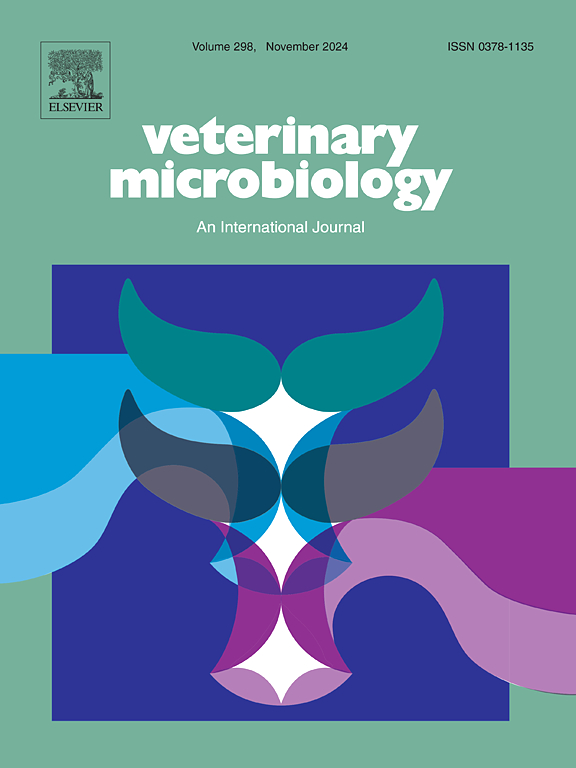多组学分析揭示了传染性法氏囊病病毒诱导鸡法氏囊基因表达和代谢的改变
IF 2.7
2区 农林科学
Q3 MICROBIOLOGY
引用次数: 0
摘要
感染性法氏囊病(IBD)是由IBDV引起的一种急性、高度传染性疾病,以炎症、法氏囊萎缩和免疫抑制为特征。本研究用三种IBDV毒株(经典的YZ,非常毒力的AH和变异的SD)感染了21日龄SPF鸡。感染后第7天,收集法氏囊样本进行转录组学和代谢组学分析。使用多变量统计分析代谢物谱,并使用KEGG富集分析识别失调通路,阐明ibdv感染的法氏囊组织的转录和代谢反应。转录组学分析发现,YZ组有1733个DEGs, AH组有5731个,SD组有84个。病毒感染组和对照组之间常见SDE基因的基因本体聚类集中在细胞成分、分子功能和生物学过程上,KEGG富集表明它们主要参与三种IBDV亚型的脂质相关代谢途径。代谢组学分析发现,感染IBDV后,每种亚型有460种代谢物发生了显著变化。脂质代谢紊乱与IBDV相关,涉及左旋肉碱等物质,KEGG分析提示主要途径与脂质相关,如花生四烯酸(AA)代谢。此外,本研究还验证了细胞因子mRNA水平、NLRP3蛋白水平和AA含量。IBDV感染在转录组水平诱导与宿主免疫应答和代谢调节相关的差异基因表达,代谢组学变化主要涉及脂质代谢。整合转录组学和代谢组学可以全面了解宿主对IBDV感染的反应。本文章由计算机程序翻译,如有差异,请以英文原文为准。
Multi-omics profiling reveals infectious bursal disease virus-induced alterations in gene expression and metabolism in chicken bursa of fabricius
Infectious Bursal Disease (IBD) is an acute, highly contagious disease caused by IBDV, characterized by inflammation, atrophy of the Bursa of Fabricius, and immunosuppression. This study infected 21-day-old SPF chickens with three IBDV strains (classical YZ, very virulent AH, and variant SD). On day 7 post-infection, bursa samples were collected for transcriptomic and metabolomic analyses. Metabolite profiles were analyzed using multivariate statistics, and KEGG enrichment analysis was used to identify dysregulated pathways, elucidating the transcriptional and metabolic responses in IBDV-infected bursa tissue. Transcriptomic analysis identified 1733 DEGs in the YZ group, 5731 in the AH group, and 84 in the SD group. Gene Ontology clustering of common SDE genes between virus-infected and control groups focused on cellular components, molecular functions, and biological processes;KEGG enrichment showed they were mainly involved in lipid-related metabolic pathways for the three IBDV subtypes. Metabolomic analysis detected 460 significantly changed metabolites per subtype after IBDV infection. Lipid metabolism disorders were associated with IBDV, involving L-carnitine and other substances;KEGG analysis indicated the main pathways were lipid-related, like arachidonic acid (AA) metabolism. Moreover, this study verified mRNA levels of cytokines, NLRP3 protein level, and AA content. IBDV infection induces differential gene expression related to host immune response and metabolic regulation at the transcriptomic level, with metabolomic changes mainly involving lipid metabolism. Integrating transcriptomics and metabolomics provides a comprehensive understanding of the host’s response to IBDV infection.
求助全文
通过发布文献求助,成功后即可免费获取论文全文。
去求助
来源期刊

Veterinary microbiology
农林科学-兽医学
CiteScore
5.90
自引率
6.10%
发文量
221
审稿时长
52 days
期刊介绍:
Veterinary Microbiology is concerned with microbial (bacterial, fungal, viral) diseases of domesticated vertebrate animals (livestock, companion animals, fur-bearing animals, game, poultry, fish) that supply food, other useful products or companionship. In addition, Microbial diseases of wild animals living in captivity, or as members of the feral fauna will also be considered if the infections are of interest because of their interrelation with humans (zoonoses) and/or domestic animals. Studies of antimicrobial resistance are also included, provided that the results represent a substantial advance in knowledge. Authors are strongly encouraged to read - prior to submission - the Editorials (''Scope or cope'' and ''Scope or cope II'') published previously in the journal. The Editors reserve the right to suggest submission to another journal for those papers which they feel would be more appropriate for consideration by that journal.
Original research papers of high quality and novelty on aspects of control, host response, molecular biology, pathogenesis, prevention, and treatment of microbial diseases of animals are published. Papers dealing primarily with immunology, epidemiology, molecular biology and antiviral or microbial agents will only be considered if they demonstrate a clear impact on a disease. Papers focusing solely on diagnostic techniques (such as another PCR protocol or ELISA) will not be published - focus should be on a microorganism and not on a particular technique. Papers only reporting microbial sequences, transcriptomics data, or proteomics data will not be considered unless the results represent a substantial advance in knowledge.
Drug trial papers will be considered if they have general application or significance. Papers on the identification of microorganisms will also be considered, but detailed taxonomic studies do not fall within the scope of the journal. Case reports will not be published, unless they have general application or contain novel aspects. Papers of geographically limited interest, which repeat what had been established elsewhere will not be considered. The readership of the journal is global.
 求助内容:
求助内容: 应助结果提醒方式:
应助结果提醒方式:


